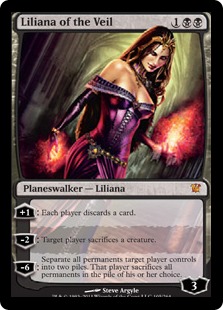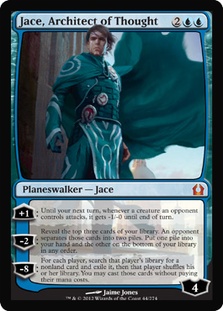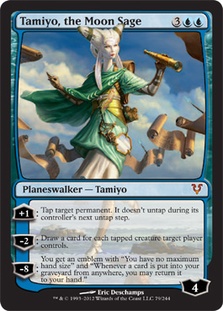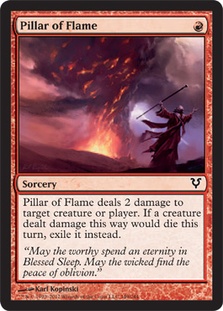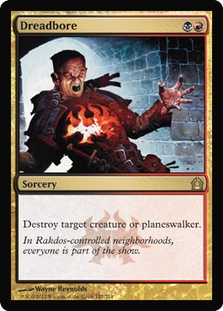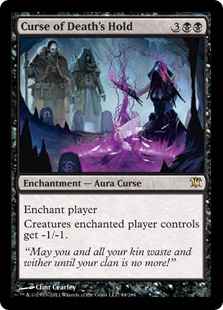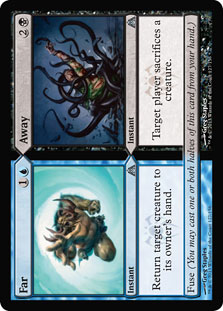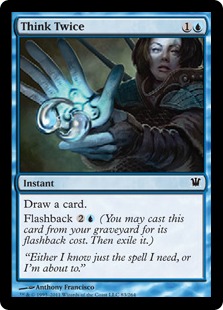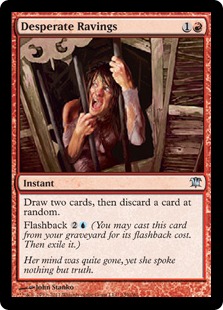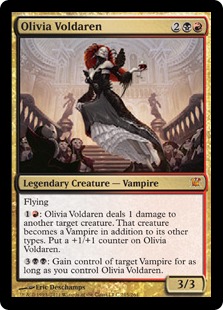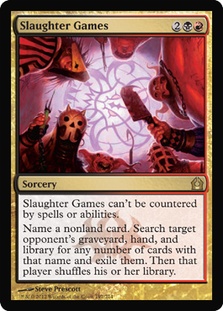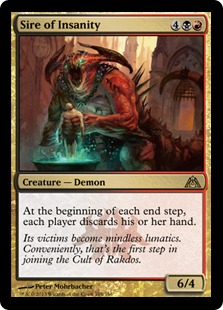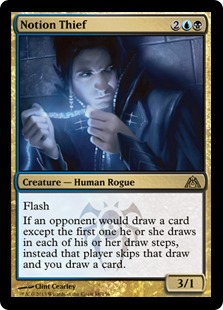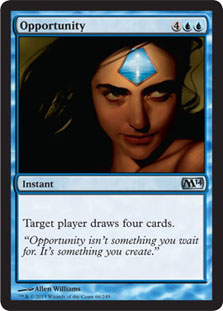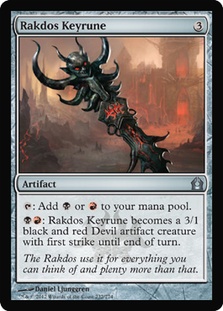1. What’s your decklist?
Creatures (4)
Planeswalkers (5)
Lands (26)
Spells (25)

2. What happened to Duskmantle Seer?
Duskmantle Seer is a great card. However, in a deck like this your main way of winning is with planeswalkers and dropping an Aetherling. When I was testing for Pro Tour Dragon’s Maze, Aetherling was the most dominant creature in Block, and it carries over to Standard as well. As much as I love Duskmantle Seer (my prior list ran four of them), it doesn’t fit in this version of Grixis. Duskmantle Seer and Ral Zarek are two very powerful cards, but they need the support of better two- and three-drop Grixis-colored creatures for them to really shine. Maybe M14 will bring exactly what Duskmantle Seer and Ral Zarek need for there to be a deck built around them.
3. How did you choose the planeswalkers and the numbers on each?
After playing the deck in multiple tournaments, the numbers kept changing and changing. Eventually, I decided to go with Liliana of the Veil; Jace, Architect of Thought; Jace, Memory Adept; Tamiyo, the Moon Sage; and Nicol Bolas, Planeswalker between the maindeck and sideboard, leaving out Ral Zarek for the reasons I mentioned above and Chandra, the Firebrand.
2 Liliana of the Veil – Liliana is a great tool against aggro and control. The reason for this is because she’s versatile, mana efficient, and great against Bant Hexproof—a real deck that should not be taken lightly. In that matchup, you have Liliana of the Veil along with Far // Away to ensure you have removal that will actually work. Against Jund, Liliana not only puts pressure on their hand or forces their creatures to be sacrificed but also happens to be the best answer for their Lilianas if they have any.
Against pure control, ultimating a Liliana is not out of the question since they won’t be able to put pressure on her to keep her loyalty counters low. The nice interaction in this matchup and others is since you don’t have a card like Sphinx’s Revelation you won’t need to build up your mana and you’ll be able to discard extra lands or Think Twice and not lose value from them. Liliana, like most planeswalkers, is not good in multiples. Therefore, being able to play multiple planeswalkers and split them by playing one or two of each is definitely the best way to go.
2 Jace, Architect of Thought – Jace, Architect of Thought is another card that impressed me very much in my testing for Pro Tour Dragon’s Maze. When this Jace was revealed, it was one of the most hyped up planeswalkers in the current Standard format, and then it took a huge dive and was seen in almost no decks. However, with the way the metagame is shaping up and the new support cards from Dragon’s Maze, Jace is once again on the rise. The reason why I went with two Jace, Architect of Thought is because it is a great card drawing spell, protects your other planeswalkers, and forces your opponent to make tough decisions with the -2 ability. They’re also put in a tough spot to decide if they should be attacking you, Jace, or another planeswalker.
1 Tamiyo, the Moon Sage – Tamiyo is another planeswalker that has been getting played less and less. I feel one is the correct number because she only shines in certain matchups: Jund and Junk Reanimator. She’s also good against other control decks. However, against hyperaggro decks, Tamiyo is too slow and should often be sided out.
The sideboard planeswalkers—Jace, Memory Adept and Nicol Bolas, Planeswalker—are both awesome, powerful cards. However, just like Tamiyo, they are weak against hyperaggressive decks. The matchups they really shine in are against Esper Control, Jund, and Junk Reanimator since the games should go long and you’ll be able to close them out with these cards. You can even side them in against other midrange decks since with all your removal the only card you will have to worry about is a flashed in Restoration Angel. Thundermaw Hellkite could be annoying as well, but most decks that have Thundermaw are decks that you would not be siding these in against anyway.
4. How did you choose the removal package?
With the huge rise in Voice of Resurgence, Pillar of Flame has once again become a great maindeck card. Other decks such as Junk Reanimator, Naya Blitz, Mono-Red Aggro, and R/G Aggro have many targets for Pillar of Flame. The increase in Strangleroot Geist and Blood Artist decks is another great argument for why Pillar of Flame should be in the maindeck.
As for the lack of Mizzium Mortars and Tragic Slip, my reasons for that can be seen in my three copies of Dreadbore and my two copies of Curse of Death’s Hold. In a deck like this, it’s rare that you can overload Mizzium Mortars and get value off it because you are trying to keep the board clear and one-for-one your opponent’s creatures with your efficient removal spells.
Curse of Death’s Hold has become the perfect removal-esque card for the current format. Between Lingering Souls, mana ramp dorks, and other small creatures, a single Curse of Death’s Hold can alter a game heavily in your favor. The other upside of Curse of Death’s Hold is that it combos nicely with the Turn side of Turn // Burn. Once Curse is in play, just Turning a creature can destroy it without any drawbacks. Dreadbore found its way into this deck because it can take down almost any creature and control decks like this one normally have a difficult time fighting planeswalkers.
As far as both split cards go, they are just so versatile and powerful that it is very hard not to have them in your 75. Besides those reasons, as I mentioned earlier Far // Away is great against the Hexproof decks. Far // Away is also nice for bouncing your own Snapcaster Mage since you are able to get more value from that nice interaction.
5. Why 4 Think Twice and 0 Desperate Ravings?
Normally, I like a split between the two. However, in a deck such as this with so few win conditions, it’s difficult to play Desperate Ravings. When your plan is to win with an Aetherling that might already be in hand, what is the point of playing Ravings and potentially discarding it? With Think Twice, you’re always able to play it without fear of losing one of your best cards. Since you don’t have access to Sphinx’s Revelation and I’m not the biggest fan of Thoughtflare, maxing out on Think Twice is a must to cycle through your deck and smooth out your draws.
6. If you’re so concerned about smoothing out your draws, why is there no Desolate Lighthouse?
Although Desolate Lighthouse was great in the Duskmantle Seer version, here I prefer Nephalia Drownyard as my special land along with Cavern of Souls (which I will get to later). Nephalia Drownyard makes the control matchup much easier since you don’t have to resolve and keep a threat on the board. Drownyard is pretty much a free roll and can also be used on yourself to dig for a Think Twice or another spell if Snapcaster Mage is in your hand. It’s also nice once you ultimate a Tamiyo, but if you ultimate a Tamiyo, you probably don’t need much more help. If you do need the help, however, Drownyard works as something like an Ancestral Recall.
7. Why no Olivia Voldaren in the maindeck?
When I was building this deck, I wanted to make sure my opponent’s creature removal spells are pretty much useless. Sure, they could use them on my Snapcaster Mage, throw three or four of them at an Aetherling, or discard them to Liliana of the Veil, but other than that I didn’t want Olivia being somewhat of a sitting duck. Olivia does make an appearance in the sideboard alongside Vampire Nighthawk because they are both good against aggressive decks and they can both catch opponents off guard since they are likely to side out their removal spells.
8. Above you mentioned Cavern of Souls. With so few creatures, how important is it to the deck?
Cavern of Souls into Aetherling is one of the best plays you can do in Standard right now. The U/W/R deck, other control decks, and any deck in general doesn’t have a good answer to that. Besides for the obvious to name Shapeshifter or Human (for your Snapcaster Mage), you can sometimes mix things up and name Vampire, Demon, or another creature type to throw your opponent off guard. Against the aggro decks, siding out a land is fine since you are often lowering your curve post-board by bringing in cheap removal or cheap creatures. Normally, I would say Cavern is the card to cut. However, remember we are bringing two Vampires in the form of Olivia Voldaren and Vampire Nighthawk in, which makes cutting Drownyard the correct call.
9. How do you plan on beating Junk Reanimator?
Junk Reanimator is a close matchup game 1. With four counterspells that exile their spells in Syncopate and Dissipate; Tamiyo the Moon Sage; and your removal spells, you can definitely keep up with them. They’re also not super-fast, which allows you time to play an Aetherling and close out the game quickly from that point. Your other planeswalkers do a nice job of controlling some of the smaller creatures as well as getting you closer to your more powerful endgame.
After sideboard, you have access to some graveyard hate, Appetite for Brains, Olivia Voldaren, and Evil Twin, which are all great cards in this specific matchup. Your basic plan is to use your counterspells wisely and try to plan out the game a few turns in advance while saving your removal for certain creatures and your Evil Twin for their other creatures (sounds tough, but you can do it!).
For example, Acidic Slime is one of their best cards against you and needs to be off the board. Otherwise, Restoration Angel also becomes a problem. Remember, they won’t have too many answers to Olivia, so try to drain out their resources and then take control of the game with her. In addition to all these cards that we’re siding in, Jace, Memory Adept is another strong option since they often dig so much through their deck with Grisly Salvage that a few hits from Jace will typically end the game.
10. What is your worst matchup?
In general, with a deck like this you don’t really have a "worst matchup." What you do have is a lot of game 1s where you need to draw the right side of your deck for each matchup. For example, a handful of Pillar of Flames won’t really shine against control decks, and the same goes for drawing too many counterspells against Naya Blitz. This means in most matchups your win percentage should go up after the first game.
If I had to pick a worst matchup, I would have to say the Naya Midrange decks since they have such powerful creatures, with many of them dodging your removal for at least a turn in the form of Advent of the Wurm and/or Thundermaw Hellkite. It crossed my mind to play some number of Ultimate Price to combat against this, but I don’t think Naya Midrange is dominant enough to warrant this reaction yet.
11. Why no Slaughter Games?
Although a very powerful card, many Jund decks have been cutting this card as well. The way Standard is now with the aggro decks are dominating the field, Slaughter Games is only good against just about half of the control decks. Sure, it’s nice against Junk Reanimator, but just like many decks, they have a variety of threats. Slaughter Games can’t catch them all (save that for Pikachu).
12. Why is there a Sire of Insanity in the board of your control deck?
Sire of Insanity is a nice one-of to catch your opponent off guard. Other control decks might think it’s safe to tap out for a threat knowing they have backup spells in their hand. Sire can come down as a nice surprise and sometimes end the game almost on the spot. Sometimes in the control mirror, an opponent will keep all their cards in hand waiting for you to make the first move. Cavern on Demon for Sire of Insanity will often make them unhappy about their play.
13. Why should I play Grixis over U/W/R?
U/W/R is a super-powerful deck that has been playtested much more and has put up better results. With that said, Grixis is something different, something exciting, and will be more difficult for your opponent to play against because they might not have experience with the matchup. With the planeswalkers and diverse removal suite, you have more answers and options against the field by playing Grixis.
14. Is this deck difficult to play?
Like most control decks, this build gives you many options, which leads to a more difficult decision tree. Which removal spells should you play and in which order is something to think about. Along with that, what spells you want to save your counters for is another thing you will have to always think about. Many times your life total will go low against the aggressive decks before you stabilize, and with Far // Away taking the spot of Tribute to Hunger, there isn’t any maindeck life gain that can make up for any mistakes.
With that said, you have to be very patient. Sometimes you might want to immediately -2 Jace, Architect of Thought to find some new cards, but other times it might be better to keep +1ing it to preserve your life total. In many games, it often comes to points where you are constantly thinking about your outs and what you need to do to play to them. And remember, you don’t want to board out all of your threats and have nothing to win the game with after you stabilize.
15. How do you match up against the Junk Aristocrats?
This matchup is surprisingly very good for you. Pillar of Flame and Curse of Death’s Hold, alongside Jace, Architect of Thought are all-stars in this matchup. Most of what they do you normally don’t care about, and their deck is based on synergy rather than power level. Since their deck is based on synergy, you have to decide how to go about breaking up their synergy. Then you can start taking over the game.
16. Is Notion Thief all it’s cracked up to be?
The rise of the U/W/R deck means an increase in Sphinx’s Revelation. Due to the main ability of Notion Thief allowing you to draw your opponent’s cards, its stock is on the rise and is still not being played around effectively. Besides Notion Thief’s main ability, being able to flash in a creature to attack opponent’s planeswalkers has value. You may recall during Delver mirrors that flashing in a Snapcaster Mage provided you a clock and was able to close out games.
17. What other options should I consider for the sideboard?
Depending on your metagame, Negate, Dispel, or extra Dissipates might be something you are looking for. If your metagame is almost all aggro, adding in some number of Rolling Temblors will be nice to combat super-aggressive draws. Additional Far // Aways could be useful in a Bant Hexproof type metagame. Honestly, the best thing you can do is wait until the morning of to adjust the final slot or two with your sideboard.
18. Have you seen anything exciting in M14 for this deck?
One or two copies of Opportunity might fit into the deck since it is more powerful than Thoughtflare. Every control deck could use an additional draw spell, and for one more mana it has none of the drawbacks of Thoughtflare. Another option is Doom Blade, which may take the spot of another removal spell.
19. Why the 2-2 split on your counterspells?
In different scenarios, each counterspell can shine in its own way. Sometimes the double blue cost of Dissipate can be an issue, and sometimes Syncopate can be a blank. Not overloading on one or the other is the best way to go.
20. How good is Rakdos Keyrune?
Rakdos Keyrune is awesome, and I would not go any lower than two. I have considered going up to three because it smooths out your mana and allows you to ramp up to the spells you want to be casting. Tamiyo, Aetherling, and Curse of Death’s Hold are even better when you can play them a full turn earlier. The fact that it also doubles as a creature allows you to fight things like Thragtusk that can sometimes be a problem for the deck.
Good luck!

